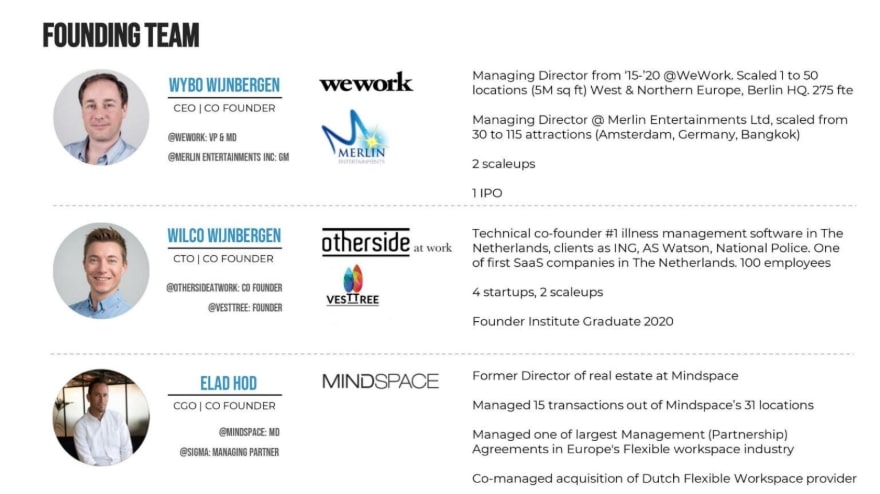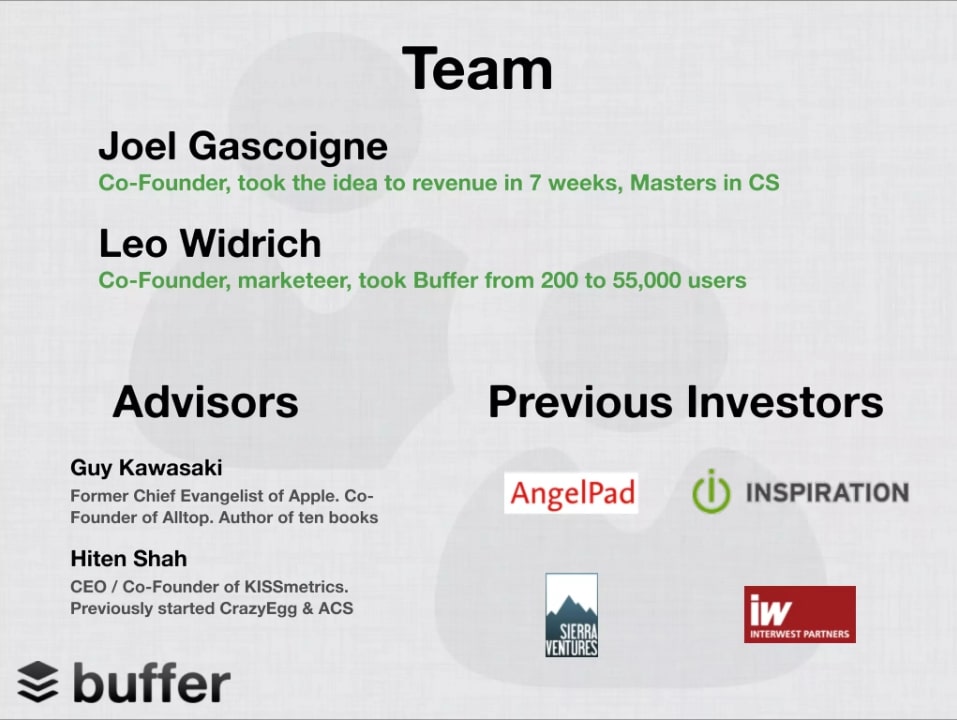Pitch Deck Team Slide
When it comes to pitching your startup, investors pay close attention to one thing above all else: the team. The team slide isn’t just a list of names and titles, it’s your chance to show who’s behind the idea and why they’re the right people to bring it to life.
In this article, we’ll walk through how to build a team slide that earns trust, highlights your strengths, and adds real weight to your pitch.
Team Slide: Definition
Team Slide is a common element in pitch decks, investor presentations, or business overviews that showcases the core members of a company or project team. Its primary purpose is to establish credibility by highlighting the experience, expertise, and relevant backgrounds of the people leading the business.
The slide functions as a trust-building mechanism that transforms abstract business concepts into tangible execution potential. Within the framework of investor psychology, this part addresses the fundamental question: “Can this team successfully execute the proposed business model?” Rather than merely listing credentials, effective team slides demonstrate role-specific competencies that directly correlate with startup challenges.
Professional investors analyze team slides through multiple lenses:
- Technical expertise alignment
- Market experience depth
- Complementary skill distribution
Each personnel presentation must justify their inclusion through measurable value contribution to the venture’s success probability.
Investor Significance
Investor significance stems from risk mitigation principles embedded in venture capital methodology. When evaluating early-stage ventures, investors face substantial uncertainty regarding market reception, competitive dynamics, and execution timelines. The team slide serves as the primary risk assessment tool for human capital evaluation.
Venture capital firms consistently report that team quality ranks as the second most important factor after market size in investment decisions. This prioritization reflects empirical evidence showing that strong teams can pivot successfully when initial strategies prove inadequate, while weak ones struggle even with superior market opportunities.
The slide also establishes credibility for financial projections and growth assumptions presented throughout the pitch deck. Investors require confidence that projected milestones are achievable given the team’s demonstrated capabilities and industry connections.
Investor Expectations
Professional investors evaluate team slides using systematic criteria designed to predict startup success probability. Primary assessment factors include domain expertise relevance, leadership track record quality, and team composition balance across essential business functions.
Domain expertise evaluation focuses on direct industry experience and technical competency alignment with the startup’s core challenges. Investors specifically seek evidence of previous problem-solving in similar market conditions, as this experience reduces execution risk significantly.
Leadership assessment examines each member’s ability to guide teams through uncertainty and resource constraints typical in startup environments. Market research data confirms that investors prioritize leadership experience over purely technical qualifications when evaluating founding teams.
| Investor Criterion | Weight % | Key Indicators |
| Domain Expertise | 35% | Industry experience, technical skills |
| Leadership Track Record | 30% | Team management, crisis navigation |
| Network Access | 20% | Industry connections, advisor quality |
| Complementary Skills | 15% | Role coverage, expertise gaps |
Common Pitfalls
Startup groups frequently undermine investor confidence through predictable team slide mistakes that signal inexperience or poor judgment. The most damaging error involves oversized teams that dilute equity unnecessarily while creating coordination complexity without proportional value addition.
Another critical pitfall emerges when teams highlight irrelevant experience that fails to demonstrate startup-specific competencies. For example, presenting corporate experience without emphasizing entrepreneurial adaptability or resource constraint management skills.
Investors also react negatively to slides lacking clear role definitions or demonstrating significant skill gaps in essential areas. When key functions like marketing, product development, or financial management remain unaddressed, investors question the team’s strategic planning capabilities.
In the presence of hidden risks, teams sometimes misrepresent individual contributions or inflate responsibilities, creating credibility issues that extend beyond the team slide into overall pitch authenticity.
Building a Winning Team Slide
Crafting a compelling visual story that showcases your team’s strengths and potential to investors.
Key Components
Constructing an effective team slide requires strategic information architecture that maximizes persuasive impact within limited visual space. Each team member profile must include role designation, relevant experience summary, and specific value proposition to the venture’s success.
Professional headshots establish visual consistency and personal connection, while concise experience descriptions focus on achievements directly applicable to startup challenges. The most compelling slides highlight quantifiable accomplishments that demonstrate each member’s capacity for results generation under pressure.
Role definitions should emphasize both current responsibilities and growth trajectory within the organization. This approach signals to investors that the team has planned for scaling challenges and succession requirements as the startup evolves.
Essential team slide components include:
- Professional photography with consistent styling
- Clear role titles reflecting actual responsibilities
- Achievement-focused experience summaries (2-3 lines maximum)
- Relevant education or certification highlights
- Strategic advisor mentions where applicable
- Contact information for key decision-makers
Visual Appeal
Visual design significantly influences investor perception of team professionalism and attention to detail. Clean, consistent formatting demonstrates organizational capabilities while poor design choices suggest operational carelessness that extends beyond presentation aesthetics.
Effective team slide design utilizes consistent spacing, typography hierarchy, and color schemes that align with overall pitch deck branding. Professional headshots should maintain uniform dimensions and background treatments to create visual cohesion across team members.
Information density requires careful balance between comprehensive coverage and visual clarity. Overcrowded slides overwhelm investors while sparse presentations may suggest insufficient team depth for complex startup challenges.
Modern pitch deck design principles favor minimalist approaches that highlight key information through strategic white space usage and typography emphasis. This design philosophy ensures that investor attention focuses on team qualifications rather than competing with decorative elements.
Team Slide Examples
Explore how successful companies have presented their teams to gain investor confidence.
Successful Case Studies
Airbnb’s original pitch deck team slide exemplifies effective founder presentation through role clarity and relevant experience emphasis. The slide highlighted each founder’s specific contribution: design expertise (Gebbia), technical development (Chesky), and strategic planning (Blecharczyk). This approach demonstrated comprehensive skill coverage without unnecessary complexity (Source).

The team slide emphasized each member’s previous startup experience and industry connections, establishing credibility for their ambitious market expansion plans. Investors could clearly understand how individual competencies would address specific business challenges like user acquisition, platform development, and operational scaling.Infinitspace’s early team slide focused on operational experience and market knowledge rather than traditional credentials. Wybo Wijnbergen’s presentation emphasized previous entrepreneurial ventures and transportation industry experience, while Elad Hod’s technical background validated the platform development approach (Source).

Buffer’s team slide strategy involved presenting a lean founding team with clear growth plans for key role additions. This approach acknowledged current limitations while demonstrating strategic thinking about team development as funding enabled expansion (Source).

Successful team slides consistently demonstrate three critical elements:
- Relevant problem-solving experience
- Complementary skill distribution
- Clear accountability structures
These examples show how effective presentation can transform individual qualifications into collective execution capability that justifies investor confidence.